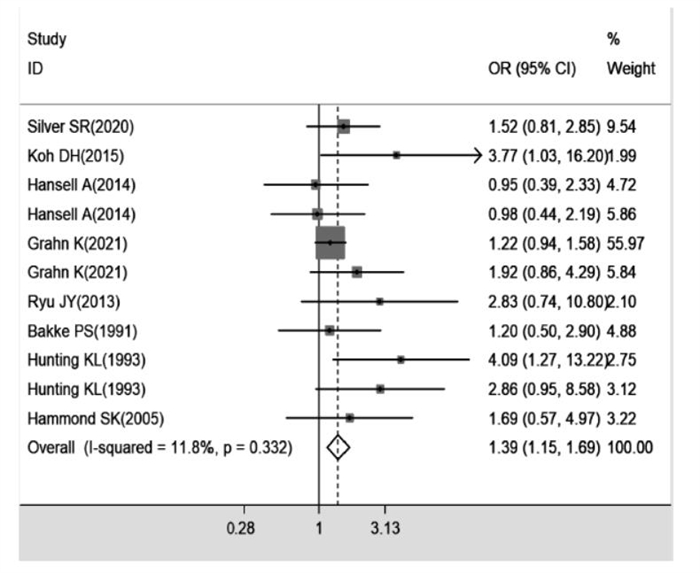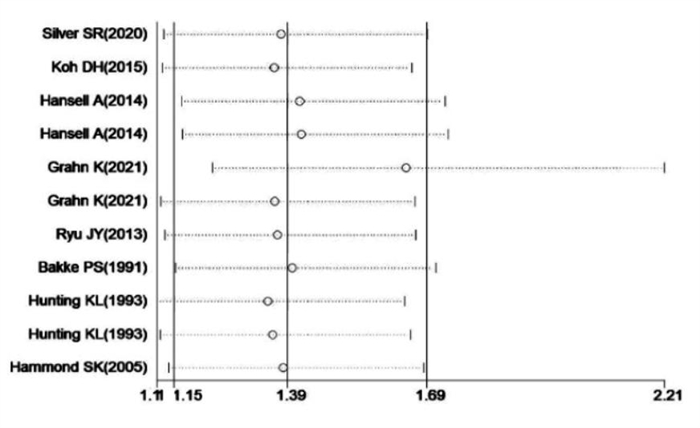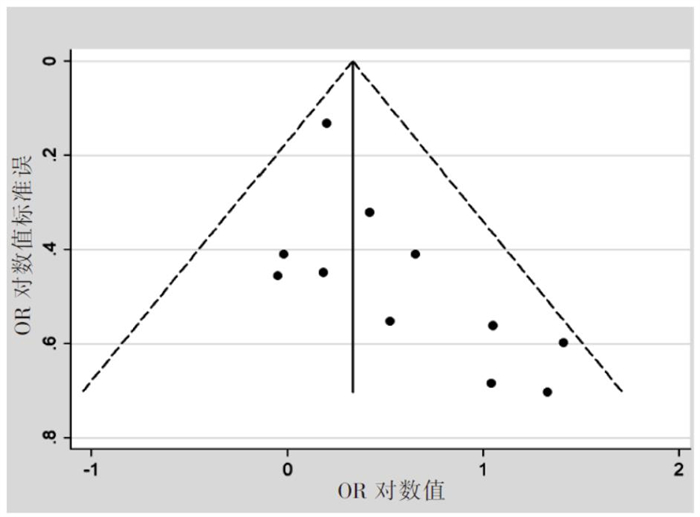Meta-analysis of relationship between occupational exposure to welding fumes and risk of chronic obstructive pulmonary disease
-
+ English摘要:目的 探讨职业接触电焊烟尘与慢性阻塞性肺疾病(chronic obstructive pulmonary disease,COPD)的关系。方法 检索从建库到2022年有关电焊烟尘和COPD的文献,数据库包括PubMed、Springer、中国知网和万方等。采用美国医疗保健研究和质量局(AHRQ)量表对符合标准的文章进行质量评估。根据I2和P值对文章进行异质性判断,并选用相应的效应模型。通过敏感性分析检验研究结果的稳定性;通过Begg’s和Egger’s检验评估发表偏倚。结果 共检索到相关文献108篇,最终有2项队列研究和6项横断面研究共11项研究纳入本次meta分析,未接触电焊烟尘的有3 425例COPD患者,接触电焊烟尘的有193例COPD患者。文献质量评分均在5分以上。各研究间异质性较低(I2 = 11.8%),采用固定效应模型对合并优势比(OR)进行分析。合并OR值表明接触电焊烟尘会增加COPD的发病风险(OR = 1.39,95%CI = 1.15 ~ 1.69),在控制了吸烟因素后依旧显示接触电焊烟尘会增加COPD的发病风险(OR=1.34,95%CI:1.10 ~ 1.63)。敏感性分析证实本次研究结果稳定。结论 劳动过程中接触电焊烟尘可增加职业人群患COPD的风险,应重视电焊烟尘工作人员的健康监护,及早控制可能的病情,在脱离岗位后要保持定期随访。
-
慢性阻塞性肺疾病(chronic obstructive pulmonary disease,COPD)是一种慢性致残呼吸系统疾病,是世界范围内的第四大死亡原因,预计到2030年将成为全球第三大死亡原因[1-4]。近几十年来,每年有2.1亿人患有慢性呼吸系统疾病[5],COPD在世界范围内普遍存在[6]。职业暴露在阻塞性气道疾病中起着重要作用[7],职业暴露是慢性支气管炎和肺功能损害等呼吸系统疾病的危险因素[8],可能导致COPD [9]。造成COPD的职业因素包括有机和无机粉尘、金属烟雾、化学气体等[10]。众所周知,电焊烟尘会对健康造成不利影响,包括尘肺病和纤维化。尽管已确定电焊烟尘对肺的危害性,但对COPD的流行病学研究并没有确定其对人体的定量危害程度,有多种结论不一的结果。许多研究报告了两者之间有正相关关系[11-13],而也有一些研究[14-18]报告并没有显著的关联。为了明确这一问题,对职业性接触电焊烟尘与COPD风险之间关系的流行病学证据进行了系统综述和meta分析,现将结果报告如下。
1. 方法
1.1 数据检索
检索从建库到2022年的有关电焊烟尘和COPD的文献,其中英文文献来自PubMed和Springer数据库,检索词为particles,welding,welders和chronic obstructive airway diseases,COPD,chronic respiratory diseases。中文文献来自中国知网和万方数据库,中文检索词为电焊烟尘、电焊工和慢性阻塞性肺疾病、呼吸系统疾病、COPD。
1.2 研究选择与提取
1.2.1 入选标准
入选标准:(1)队列研究、病例对照研究(对照组为未患慢性阻塞性肺疾病或COPD的人群)或横断面研究;(2)职业暴露的结果是慢性阻塞性肺病或COPD;(3)暴露条件为电焊烟尘或电焊工;(4)具备关键效应量[hazard ratio(HR)、relative risk(RR)或OR、置信区间(CI)]和其他必备的信息。
排除标准:(1)研究中未表明暴露因素为电焊烟尘;(2)综述、病例报告、会议、信件和动物研究;(3)没有提供OR值的研究或提供的原始数据不能计算出OR值和95%CI值的研究。
1.2.2 数据提取
首先,通过阅读,删除重复文献。其次,仔细浏览论文的标题和摘要,根据纳入和排除标准,对照组为未接触电焊烟尘或者虽接触但浓度较低组,接触组为接触电焊烟尘的工人或高浓度接触组。再次,查阅结局是否符合本次研究目的。为了进一步完善研究内容,还对符合要求的相关文献的参考文献进行了比对。本研究关注、提取的内容包括作者(发表年限)、研究类型、国家、样本量、研究对象年龄、COPD确诊来源、OR(95% CI)值及调整的混杂因素。
1.2.3 文献质量评估
依据美国医疗保健研究和质量局的量表(AHRQ)[19]评估文献质量。自评量表共有11个项目(分别用“是”“否”及“不清楚”作答[11]:(1)是否明确了资料的来源(调查,文献回顾)?(2)是否列出了暴露组和非暴露组(或病例和对照)的纳入及排除标准或参考了以往的出版物?(3)是否给出了鉴别患者的时间阶段?(4)如果不是人群来源的话,研究对象是否连续?(5)评价者的主观因素是否掩盖了研究对象其他方面情况?(6)描述了任何为保证质量而进行的评估(如对主要结局指标的检测、再检测);(7)解释了排除分析的任何患者的理由;(8)描述了如何评价和(或)控制混杂因素的措施;(9)如果可能,解释了分析中是如何处理丢失数据的;(10)总结了患者的应答率及数据收集的完整性;(11)如果有随访,查明预期的患者不完整数据所占的百分比或随访结果。每个项目值1分。文献由2名研究人员按照评估方案进行评分,任何不一致的分数都通过小组讨论解决。文献质量分为以下几类:低质量= 0 ~ 3分;中等质量= 4 ~ 7分;高质量= 8 ~ 11分。
1.2.4 统计学分析
应用Stata 13.0进行统计学分析。通过I2和P值进行异质性判断,当P > 0.10且I2 ≤ 25.0%时,认为异质性低,采用固定效应模型分析;否则采用随机效应模型分析[20]。通过敏感性分析探索研究的异质性来源[21]。采用Begg’s或Egger’s法和漏斗图[22]检验发表偏倚。
2. 结果
2.1 文献检索
检索过程如图 1所示。共检索到相关文献108篇(其中PubMed 87篇、Springer 10篇、中国知网11篇)。根据纳入和排除标准,剔除不符合研究目的和要求的文献后,最终有8篇研究[11-18]入选进行下一步的meta分析。
本次研究共检索到8篇文章,其中队列研究2篇[11, 14],横断面研究6篇[12-13, 15-18],共11项研究结果,未接触电焊烟尘的有3 425例COPD患者,接触电焊烟尘的有193例COPD患者。暴露人群为电焊作业或电焊工或整车焊接等工种。根据研究区域,3项[13-14, 17]来自美国,2项[12, 16]来自韩国,瑞典[11]、新西兰[15]、挪威[18]各1项。纳入文献的基本特征见表 1。
表 1 纳入文献的基本特征作者(发表年份) 研究类型 国家 病例/非暴露 病例/暴露 年龄/岁 COPD确诊来源 OR(95%CI)值 调整的混杂因素 质量评分 Silver等[14](2020) 队列研究 美国 1 100/7 144 13/48 50 ~ 62 医生诊断 1.52(0.81 ~ 2.85) 性别,民族,文化,家庭收入,吸烟 8 Grahn等[11](2021) 队列研究 瑞典 930/20 069
1 195/22 30261/1 016
6/6925 ~ 70 医生诊断 男:1.22(0.94 ~ 1.58)
女:1.92(0.86 ~ 4.29)年龄,吸烟 9 Koh等[12](2015) 横断面研究 韩国 未提供 37/240 >20 FEV1/FVC < LLN 3.77(1.03 ~ 16.20) 年龄,身高 7 Hansell等[15](2014) 横断面研究 新西兰 52/448
33/32012/126
14/10225 ~ 75 FEV1/FVC < LLN,医生诊断 0.98(0.44 ~ 2.19)
0.95(0.39 ~ 2.33)性别,年龄,吸烟,民族,家庭收入 6 Ryu等[16](2013) 横断面研究 韩国 3/102 15/222 31 ~ 53 FEV1/FVC < 70% 2.83(0.74 ~ 10.80) 年龄,体质量,工龄 5 Hammond等[17](2005) 横断面研究 美国 8/357 7/365 < 30,30 ~ 60,> 60 医生诊断 1.69(0.57 ~ 4.97) 年龄,呼吸系统疾病家族史,民族,吸烟,性别 7 Hunting等[13](1993) 横断面研究 美国和加拿大 30/74 20/333 48 ~ 71 FEV1/FVC < LLN > 4年:
4.09(1.27 ~ 13.22)
1 ~ 3年:
2.86(0.95 ~ 8.58)年龄,工龄,吸烟 6 Bakke等[18](1991) 横断面研究 挪威 74/未提供 8/未提供 18 ~ 73 FEV1/FVC < 70% 1.20(0.50 ~ 2.90) 性别,年龄,吸烟 5 注:LLN(lower limit of normal),正常值下限;FEV1(forced expiratory volume in the first second),第一秒用力呼气量;FVC(forced vital capacity),用力肺活量。 2.2 meta分析
纳入的11项研究存在较低的异质性(I2 = 11.8%,P = 0.332),因此采用固定效应模型进行分析。合并OR值表明接触电焊烟尘会增加COPD的发病风险(OR = 1.39,95%CI = 1.15 ~ 1.69),森林图分析见图 2。同时根据混杂因素中是否吸烟进行了调整,在控制了吸烟因素后显示接触电焊烟尘会增加COPD的发病风险(OR = 1.34,95%CI:1.10 ~ 1.63)。
2.3 敏感性分析
为了进一步探讨可能的异质性来源,我们对文献进行了敏感性分析。敏感性分析结果见图 3。图中结果显示的是在删除一项研究后,剩余文献的合并OR值。11项研究合并的OR值范围为1.35(95%CI = 1.11 ~ 1.65)~1.64(95%CI = 1.23 ~ 2.21)。没有发现个别研究显著影响整体OR值,表示本次研究的稳定性较好。
2.4 发表偏倚
对纳入分析的文献和数据进行发表偏倚检验,Begg’s等级相关检验和Egger’s直线回归法结果均提示该研究存在发表偏倚(P = 0.008、0.032),见图 4。由于研究数量较少,采用减补法进一步评估发表结果的稳定性。在初步meta分析中添加了4个假设的研究,以满足无发表偏倚的要求,增加4个假设研究后的结果为OR = 1.27(95%CI = 1.05 ~ 1.52),与原结果范围一致,依旧支持电焊烟尘会导致患COPD的风险增加的结论。
3. 讨论
本次研究甄选得到的11项研究结果综合表明,劳动过程中接触电焊烟尘是COPD发病的危险因素(OR = 1.39,95% CI:1.15 ~ 1.69),且各研究间异质性较低,结果可靠性较好。
不同职业类别的劳动者在职业活动中若接触有害气体、灰尘和烟雾,均可增加患COPD的风险,如农民、采矿工人、建筑工人和其他行业(如接触镉和铝等金属烟雾)的操作工[23],同时暴露于职业有害因素和吸烟会显著增加患COPD的风险。吸烟是研究得最多的COPD相关的风险因素,许多研究一致认为吸烟是COPD疾病发展的主要危险因素。由于COPD和吸烟之间的联系较强,COPD经常被视为吸烟者的疾病。然而,现有足够的证据表明不吸烟者也可能患COPD。在日本、英国和美国均约有近四分之一确诊的COPD病例发生在非吸烟者中[24]。因此在本次meta分析中,对吸烟因素进行了调整,调整后汇总的OR = 1.34(95%CI:1.10 ~ 1.63),显示不吸烟者暴露于电焊烟尘中发生COPD的风险依旧增加。接触电焊烟尘导致的COPD致病机制尚不清晰,但有研究发现劳动者接触生产性粉尘后支气管黏膜反复受刺激,因此其清除异物的能力降低,细菌更容易侵入呼吸道而引起感染,出现不可逆性的气流受限[25];长期吸入粉尘可导致呼吸道纤毛缩短,诱导COPD的发生[26];以上在老年患者中尤其容易出现。当前我国大部分人群对COPD缺乏充分的认识,这导致了我国大多数已患COPD的人群(尤其是退休老年人)没有得到有效重视和及时控制。Violi等[27]研究发现,COPD是导致老年人肺部感染发病住院风险最高的基础疾病,造成的直接和间接经济损失呈现逐年升高的趋势。
本次meta分析有一些局限性:第一,本研究虽然对中英文文献都进行了检索,但并没有符合要求的中文文献纳入。第二,未根据接触电焊烟尘的工龄进行分析,因为多数纳入的研究只评估了参与者是否接触过电焊烟尘。第三,未进一步考虑接触的电焊烟尘浓度,因为纳入的研究只有1篇测量了接触浓度。第四,本研究存在一定的发表偏倚,提示当前可能有灰色文献未被查询到。
作者声明 本文无实际或潜在的利益冲突 -
表 1 纳入文献的基本特征
作者(发表年份) 研究类型 国家 病例/非暴露 病例/暴露 年龄/岁 COPD确诊来源 OR(95%CI)值 调整的混杂因素 质量评分 Silver等[14](2020) 队列研究 美国 1 100/7 144 13/48 50 ~ 62 医生诊断 1.52(0.81 ~ 2.85) 性别,民族,文化,家庭收入,吸烟 8 Grahn等[11](2021) 队列研究 瑞典 930/20 069
1 195/22 30261/1 016
6/6925 ~ 70 医生诊断 男:1.22(0.94 ~ 1.58)
女:1.92(0.86 ~ 4.29)年龄,吸烟 9 Koh等[12](2015) 横断面研究 韩国 未提供 37/240 >20 FEV1/FVC < LLN 3.77(1.03 ~ 16.20) 年龄,身高 7 Hansell等[15](2014) 横断面研究 新西兰 52/448
33/32012/126
14/10225 ~ 75 FEV1/FVC < LLN,医生诊断 0.98(0.44 ~ 2.19)
0.95(0.39 ~ 2.33)性别,年龄,吸烟,民族,家庭收入 6 Ryu等[16](2013) 横断面研究 韩国 3/102 15/222 31 ~ 53 FEV1/FVC < 70% 2.83(0.74 ~ 10.80) 年龄,体质量,工龄 5 Hammond等[17](2005) 横断面研究 美国 8/357 7/365 < 30,30 ~ 60,> 60 医生诊断 1.69(0.57 ~ 4.97) 年龄,呼吸系统疾病家族史,民族,吸烟,性别 7 Hunting等[13](1993) 横断面研究 美国和加拿大 30/74 20/333 48 ~ 71 FEV1/FVC < LLN > 4年:
4.09(1.27 ~ 13.22)
1 ~ 3年:
2.86(0.95 ~ 8.58)年龄,工龄,吸烟 6 Bakke等[18](1991) 横断面研究 挪威 74/未提供 8/未提供 18 ~ 73 FEV1/FVC < 70% 1.20(0.50 ~ 2.90) 性别,年龄,吸烟 5 注:LLN(lower limit of normal),正常值下限;FEV1(forced expiratory volume in the first second),第一秒用力呼气量;FVC(forced vital capacity),用力肺活量。 -
[1] CELLI B R, DECRAMER M, WEDZICHA J A, et al. An official American thoracic society/European respiratory society statement: research questions in chronic obstructive pulmonary disease[J]. Am J Respir Crit Care Med, 2015, 191(7): 24-27.
[2] POSTMA D S, BUSH A, VAN DEN BERGE M. Risk factors and early origins of chronic obstructive pulmonary disease[J]. Lancet, 2015, 385(9971): 899-909. doi: 10.1016/S0140-6736(14)60446-3
[3] ABRAMSON M J, PERRET J L, DHARMAGE S C, et al. Distinguishing adult-onset asthma from COPD: a review and a new approach[J]. Int J Chron Obstruct Pulm Dis, 2014, 9: 945.
[4] VOS T, FLAXMAN A D, NAGHAVI M, et al. Years lived with disability(YLDs)for 1160 sequelae of 289 diseases and injuries 1990-2010: a systematic analysis for the Global Burden of Disease Study 2010[J]. Lancet, 2013, 380(9859): 2163-2196.
[5] MAMANE A, BALDI I, TESSIER J F, et al. Occupational exposure to pesticides and respiratory health[J]. Eur Respir Rev, 2015, 24(136): 306-319. doi: 10.1183/16000617.00006014
[6] MURRAY C J L, LOPEZ A D. The global burden of disease: a comprehensive assessment of mortality and disability from diseases, injuries, and risk factors in 1990 and projected to 2020[M]. Cambridge: Harvard University press: 429-453.
[7] TAGIYEVA N, SADHRA S, MOHAMMED N, et al. Occupational airborne exposure in relation to Chronic Obstructive Pulmonary Disease (COPD)and lung function in individuals without childhood wheezing illness: a 50-year cohort study[J]. Environ Res, 2017, 153: 126-134. doi: 10.1016/j.envres.2016.11.018
[8] SCHENKER M B, CHRISTIANI D, CORMIER Y, et al. Respiratory health hazards in agriculture[J]. Am J Respir Crit Care Med, 1998, 158(5 Pt 2): S1-S76.
[9] BLANC P D, TORéN K. Occupation in chronic obstructive pulmonary disease and chronic bronchitis: an update[J]. Int J Tuberc Lung Dis, 2007, 11(3): 251-257.
[10] BLANC P D, MENEZES A M, PLANA E, et al. Occupational exposures and COPD: an ecological analysis of international data[J]. Eur Respir J, 2009, 33: 298-304.
[11] GRAHN K, GUSTAVSSON P, ANDERSSON T, et al. Occupational exposure to particles and increased risk of developing chronic obstructive pulmonary disease(COPD): a population-based cohort study in Stockholm, Sweden[J]. Environ Res, 2021, 9: 111739.
[12] KOH D H, KIM J I, KIM K H, et al. Welding fume exposure and chronic obstructive pulmonary disease in welders[J]. Occup Med(Lond), 2015, 65, (1): 72-77. doi: 10.1093/occmed/kqu136
[13] HUNTING K L, WELCH L S. Occupational exposure to dust and lung disease among sheet metal workers[J]. Br J Ind Med, 1993, 50(5): 432-442.
[14] SILVER S R, ALARCON W A, LI J. Incident chronic obstructive pulmonary disease associated with occupation, industry, and workplace exposures in the health and retirement study[J]. Am J Ind Med, 2021, 64(1): 26-38. doi: 10.1002/ajim.23196
[15] HANSELL A, GHOSH R E, POOLE S, et al. Occupational risk factors for chronic respiratory disease in a New Zealand population using lifetime occupational history[J]. J Occup Environ Med, 2014, 56(3): 270-280. doi: 10.1097/01.jom.0000438382.33221.dc
[16] RYU J Y, LEE S Y, KIM D H. Obstructive pulmonary function impairment among Korean male workers exposed to organic solvents, iron oxide dust, and welding fumes[J]. Ind Health, 2013, 51(6): 596-602. doi: 10.2486/indhealth.2012-0213
[17] HAMMOND S K, GOLD E, BAKER R, et al. Respiratory health effects related to occupational spray painting and welding[J]. J Occup Environ Med, 2005, 47(7): 728-739. doi: 10.1097/01.jom.0000165748.31326.e8
[18] BAKKE P S, BASTE V, HANOA R, et al. Prevalence of obstructive lung disease in a general population: relation to occupational title and exposure to some airborne agents[J]. Thorax, 1991, 46(12): 863-870. doi: 10.1136/thx.46.12.863
[19] 曾宪涛, 刘慧, 陈曦, 等. Meta分析系列之四: 观察性研究的质量评价工具[J]. 中国循证心血管医学杂志, 2012, 4(4): 297-299. https://www.cnki.com.cn/Article/CJFDTOTAL-PZXX201204008.htm [20] HIGGINS J P, THOMPSON S G. Quantifying heterogeneity in a meta-analysis[J]. Stat Med, 2002, 21: 1539-1558. doi: 10.1002/sim.1186
[21] HIGGINS J P, THOMPSON S G, DEEKS J J, et al. Measuring inconsistency in meta analyses[J]. BMJ, 2003, 327: 557-560. doi: 10.1136/bmj.327.7414.557
[22] EGGER M, SMITH G D, SCHNEIDER M, et al. Bias in meta analysis detected by a simple, graphical test[J]. BMJ Clin Res, 1997, 315: 629-634. doi: 10.1136/bmj.315.7109.629
[23] ALIF S M, DHARMAGE S C, BOWATTE G, et al. Occupational exposure and risk of chronic obstructive pulmonary disease: a systematic review and meta-analysis[J]. Expert Rev Respir Med, 2016, 10(8): 861-872. doi: 10.1080/17476348.2016.1190274
[24] CHRISTENSON S A, SMITH B M, BAFADHEL M. Chronic obstructive pulmonary disease[J]. Lancet, 2022, 399(10342): 2227-2242. doi: 10.1016/S0140-6736(22)00470-6
[25] 赵元璐. 扬州地区慢性阻塞性肺疾病发病情况区域性调查报告及比较分析[D]. 扬州: 扬州大学, 2020. [26] 吴苏佶, 魏毅, 石俊青, 等. 肺纤维化合并肺气肿综合征的临床特征与危险因素分析[J]. 中国呼吸与危重监护杂志, 2021, 20(1): 4-11. https://www.cnki.com.cn/Article/CJFDTOTAL-ZGHW202101003.htm [27] VIOLI F, CANGEMI R, FALCONE M, et al. Cardiovascular complications and short-term mortality risk in community-acquired pneumonia[J]. Clin Infect Dis, 2017, 64(11): 1486-1493. doi: 10.1093/cid/cix164
-
期刊类型引用(1)
1. 徐丽丽,栗继祖,徐新华. 基于智能综采集控台人机系统的认知负荷研究. 中国煤炭. 2023(08): 54-64 .  百度学术
百度学术
其他类型引用(6)






 下载:
下载:



